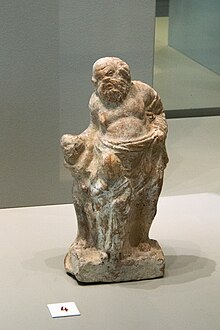
In the ancient Greece, a paidagogos παιδαγωγός (Ancient greek) was a slave entrusted with supervising boys from the age of seven and in Roman Republic, the paedagogus, plural paedagogi or paedagogiani, was a slave or a freedman who taught the sons of Roman citizens the Greek language. In the period of the Roman Empire, the paedagogus became the director of the paedagogium.

There were no public schools in the early Roman Republic so boys were taught to read and write by their parents or by educated paedagogi, usually of Greek origin.
A representation of a paedagogus was painted as a graffito on the walls of the paedagogium of the Palatine, and it represents his social and cultural formation, which is identified such a slave.
An inscription of the second century dedicated to the Roman emperor Caracalla lists twenty-four paedagogi. In some cases, the title of paedagogus is connected with private elite families.
Being a paedagogus meant obeying conduct and duty laws.
In the imperial institution, the title of paedagogus refers to the duty of child-attendant or tutor rather than a teacher. The other title of paedagogus refers to a variety of interrelated capacities related to the offspring of the imperial family and aristocracy: disciplina (academic and moral instruction), custodia (companion and protector) and decorum (directives of precepts for public behaviour). There is a third title which appears in three inscriptions and means the director of the paedagogium (praeceptor).
References
- ^ George 2013, p. 70, "Reading the Pages of the Domus Caesaris: Pueri Delicati, Slave Education, and the Graffiti of the Palatine Paedagogium".
- ^ George 2013, p. 73, "Reading the Pages of the Domus Caesaris: Pueri Delicati, Slave Education, and the Graffiti of the Palatine Paedagogium".
- ^ Lara Peinado, Federico; Cabrero Piquero, Javier; Cordente Vaquero, Félix; Pino Cano, Juan Antonio (2009). Diccionario de instituciones de la Antigüedad (in Spanish) (1ª ed.). Fuenlabrada (Madrid): Ediciones Cátedra (Grupo Anaya, Sociedad Anónima). p. 409. ISBN 9788437626123.
- Lecture 13: A Brief Social History of the Roman Empire by Steven Kreis. Written 11 October 2006. Retrieved 2 April 2007.
- Adkins, Lesley; Adkins, Roy (1998). Handbook to Life in Ancient Rome. Oxford: Oxford University Press. p. 211. ISBN 0-19-512332-8.
- Werner, Paul (1978). Life in Rome in Ancient Times. Geneva: Editions Minerva S.A. p. 31.
- CIL 6.8982-6. Dedication (October, AD 198)
- CIL 6.1502
- CIL 6.7290, 9740
- cf. Dig. 33.7.12.32
- Mohler 1940, p. 267-273. sfn error: no target: CITEREFMohler1940 (help)
- Bradley 1991, p. 37-64. sfn error: no target: CITEREFBradley1991 (help)
- Bradley 1991, p. 71-72. sfn error: no target: CITEREFBradley1991 (help)
Bibliography
- George, Michele (2013). Roman Slavery and Roman Material Culture. University of Toronto Press. p. 240. ISBN 9781442644571.